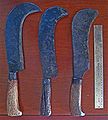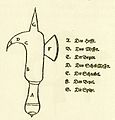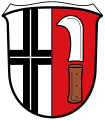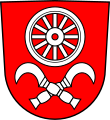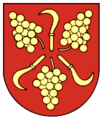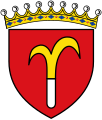Hip (tool)
A hip (also Heppe , Häbe, Knipp , Säsle , Rebmesser , Schneier or Gertel ) is a tool that, depending on its size and design, is used for various tasks in agriculture, forestry, viticulture and horticulture. The sickle-shaped, curved blade with a tip that is more or less bent downwards is typical. While maintaining this basic form, different variants have developed over the centuries, depending on the region and type of use. Hip-shaped tools have been known in many European countries since Roman times and in some cases are still in use today, for example in forestry and horticulture.
In some regions hip hips still have a cultural meaning, for example in England, where the fascination of billhooks is cultivated in special associations. Hip-shaped tools used to be artistically decorated, for example the knipp in Siegerland or the handles of vine knives in the Palatinate. The cultural and historical importance of Hippen is still demonstrated today by numerous municipal coats of arms with vine knives.
Larger hips were also used as weapons in the past (see Hippe (weapon) ) and some had their own names that are still in use today, such as the Säsle for a medieval short sword or the (or the) sax , with the latter (or the latter) in the Palatinate space on the as Sesel passed called pruning hooks. Other regional names have their origins in the falx used by the Romans .
The second meaning of the hip as a weapon is reflected in literature, in that the hip, like the scythe, is an allegory for death.

Designations
In 1522, Martin Luther used the East Central German term "Hippe" for sickle knife, hand ax four times for the translation of the Greek δρέπανον ( drépanon ) (Rev. 14,17-19 ) and thus introduced it into New High German . The Old High German variants hā̌bba, hā̌ppa, hebba, heppa lead back to Indo-European * (s) kē̌p- , * (s) kō̌p- , * (s) kā̌p- via ancient German * hā̌ҍjō , * hē̌ҍjō or * habbō .
However, the term hip was also used as a synonym for sickle . The following is noted in the dictionary of German synonyms : Die Hippe bed. a curved cutting tool attached to a longer or shorter handle for cutting off like chopping off. So not only is the sickle poetically called hip, but it is usually also called z. B. the curved garden knife for pruning the trees, etc., the curved vintner's knife for pruning the vines, the small curved knife for pruning the flowers, - the garden stick, vintner stick (vine knife), flower stick. It is also noted there: “ The hip is a subsidiary form vd. ahd 'diu happa', mhd. happa, scenic. also Heppe, Häpe (on the Lower Rhine), Hâpe (in Wirtemberg) etc. ”.
In southern Baden, Alsace and Switzerland, the Hippe is used in a longer version with 40 cm and is known as Säsli ( Breisgau , Ortenau and central Black Forest) or Gertel (Switzerland and the neighboring Markgräflerland ). Thirteen names are known in southern Baden alone, such as Gertel and Säsli, local names such as Bäcksel, Adze, Schnäker, Riisäsli, Gertmesser or Häpe . In Swabian, the name Hoob is also used . In other parts of Swabia, such as in the Bavarian region of Swabia around Augsburg, the Hippe (Reisachmesser) is also known as Schnaier , in the Mindeltal as a modification of Schnaiter .
The name Säsli (or Sächsli ) is derived from the short sword, the sax, used by the Saxons in the Middle Ages. From ahd. Gertari or kertari “knife for cutting or chopping off rice”, the name Gertel developed from mhd. Gerter and gertel . In the Walser Museum in Alagna Valsesia there is an exhibit of a slicing knife , which there is called a Pfailtscha, derived from the Italian falce "Falx".
In addition to the name Knipp , Häbe, Häpe and Häwe are also used in Siegerland . There the Knipp is part of the coat of arms of the Siegen-Wittgenstein district .
In Austria, the term praxe for the knife-like hip shape is common. This is how Machatschek calls Carinthia the name Braxe or Praxn . The practice used in hunting does not have a curved blade.
In Luxembourg the Hippen , the size of a knife, are called Hipp, Héip, Häpp or Heep, in some areas they are also called Kromm , Krëmmes or Krummeß according to their shape (Luxembourg dictionary), (Der Weinbau an Mosel and Saar 1845), while in the Palatinate the curved ones Vine knives are called Sesel . The word Sächsel, which is also used in the Palatinate , also describes the " vintner's knife with a curved edge for cutting off the grapes or for pruning the vines", and in some places has other meanings such as "slightly sickle-like curved knife for chopping", "knife for caring for the fruit trees" or "curved knife for cutting willow". According to the Palatinate dictionary, these terms are derived from ahd. Sahsilîn, sehselin and are a diminutive of ahd. Sahs "sword, knife" and thus have the same root as the southern Baden Säsli .
Other names are foliage knife, cutting knife, whip knife, pointed knife , Hag knife , stick knife or wooden knife . A regional peculiarity is the name Stäckespitzer in some wine-growing areas in the Kaiserstuhl and on the Tuniberg . Here vine stakes in particular were sharpened with the Haumesser, which is why the name Säsli , which is otherwise common in Breisgau , is not common in these communities .
For the small variants with which vines are cut or that are used for gardening, there is also a variety of regional names or the knife is named differently in one and the same area according to the function. This should also be strictly observed, because sickles are usually cutting tools, while Gertel, Praxe and Hääp (Hunsrück) are slicing knives. These different areas of application are of course also expressed in the blade geometry and dimensions. While the cutting tools have strong blades with cutting angles from 30 °, sickles are usually filigree forged and have thin blades that can be sharpened.
For example, in South Tyrol the name Runggl or Runggel is widespread for hip-shaped knives that are used for cutting grapes, while vine knives that are used to harvest grapes are called Reber or Raggaun in some places . The word Runggel is derived from the Italian Roncola , the word for a little hip. The name Rebmutz is known in the Bern area .
Saxon hip, 13th or 14th century. Today Hoflößnitz
Billhooks ( Kent / England )
Billhook ( Devon / England )
Serpette vendange (France, Loire )
Historical representations
Hip-shaped knives have been around since ancient times. Knife-like sickles made of bronze, which were built as massive hips and which were used as leaf sickles, are proven. A copy can be viewed in the Württemberg State Museum in Stuttgart . A tool similar to the Hippe was also used by the Romans under the name falx arboria et silvatica . These were foliage or tree knives with which one cut foliage from the trees, which was fed to the cattle in fresh or dried form. These falces were also attached to long handle bars in order to be able to cut foliage at greater heights. Roman craftsmen such as basket weavers and rod binders also used such leaf knives to get their "raw material" from bushes or trees. In addition, the cleaver was used for all kinds of clearing work. Such a knife-like falx was found, for example, at Niederbieber Castle ( Wolfgang Gaitzsch ). A smaller variant was the vine knife, the falx vinatoria .
Columella describes in his extensive agricultural textbook De re rustica, which was published in German in 1538, a multi-purpose device for viticulture and fruit growing.
In the German edition of the textbook Ruralia commoda , published by Petrus de Crescentiis around 1300 , the use of the heppelyn to refine pomegranate is described: “They are managed with the plants that are cut off from irer muter stāme. But it is better that it sy a zwyg an elen-long and so thick than an ax helmet at both ends finished with a sharp cleynen heppelyn and that he is coated with suwe mist wole on the head and (n) on the lower teyle and get bad sunk ” .
Another illustration of the use of a knife-like hip can be found in the German edition of the silviculture manual by the French Henri Louis Duhamel du Monceau from 1766. It describes the manufacture of fascines , as they were used in river engineering to fortify the banks. Fascines were also used in large numbers by the military for the installation of protective weirs when building entrenchments . Likewise, hips were used in military fortifications to extract and process the wood necessary for the production of entanglements .
Forms and uses
Larger cutting knives such as Gertel, Knipp or Säsle are used to cut off twigs and branches , to clear brush or to make bundles of sticks or coarse wood, while the vine knives that were used in the past are small knives that have their own names depending on the landscape. In fruit and horticulture, smaller versions are used, which are often offered as folding knives .
The typical thing about a hip is the sickle-like curved blade with a more or less forward pointing tip. For example, if you work with the heavy version in the undergrowth, you can not only cut, but also tear with the curved front part. Depending on the type of use and region, the hip also differ in their shape. In the case of heavy designs for carving work, the cutting edge is almost straight except for the foremost part. There are also regional forms with a less pronounced or completely missing “eagle beak”.
In the shoemaker's trade, hip-shaped knives, the so-called shoemaker's bars, were used in the past .
Hip as a knife
The haumesserartige Hippe is in the forestry Essential Culture care device and serves to forestry workers for limbing the strains , for chopping brushwood and the cutting off of brushwood. Furthermore, stick rashes are removed with the hip . It can be used up to a branch diameter of approx. 5 cm. The handle stick or one-hand culture stick is a version with an approx. 60 cm long handle that is used for delimbing taller shrubs and small trees.
Knife-like hips are called billhooks in England , and serpe or serpette for the small versions in France . Homeland Guards in Great Britain classify the billhook as an important national treasure.
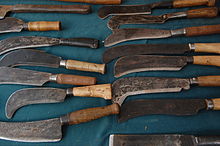
Billhooks are also very popular among collectors. You can find discussion forums on the Internet in which fans of these devices meet and present their achievements, such as artfully decorated Hauberg knobs from Siegerland. The Serpe is also a sought-after collector's item in France . In Germany, the Haubergknipp enjoys a certain popularity in the Siegerland and is also the coat of arms of the district of Siegen .
The following describes the use of the knife-like hips in German-speaking countries, whereby these have been used in a similar or the same way everywhere, regardless of their regional designation.
Practices
Especially in regions with little grassland, cutting used to be a form of fodder production. Tools like the hip played an important role in the refurbishment. In Carinthia , for example , the hips known as Praxn, Braxn or chopping knives were used to chop fine branches on the chopping block. The praxn's “beaks” had to be sharpened. In this way, the distant rods were cut off immediately when they were drawn in. The back of the practice was often provided with an additional blunt hook, which could also be used to pull branches. So you could pick up branches from the ground without having to bend down too far. There are also different shapes for the practices depending on their use. So the cut branches (branches) are processed with a Tassnpraxn , while foliage practices are used to cut the leaves . The knives, known as Kress in Montafon , have a blunt hook at the end of the handle , just like the Swiss Gertel , with which you can hang the knife in your trouser belt while climbing.
Gertel
The forms of the hip known as Gertel are numerous in Switzerland. While in Germany a hip bent forward is known as the Schweizer Gertel , in Switzerland this version is called Ticino Gertel or Italian Gertel . There are also various shapes, including those without the curved front part that is otherwise typical for hipsters. The Bernese Gertel is simply built without a "beak", while the Freiburg Gertel has a blunt hook on the top. There are other Gertel in the Aargau form or in the Vaudois form . The Swiss belt with leather handle, which is often used today, is 43 cm long and weighs between 600 and 750 g.
According to the Gertel in its use " can be classified between ax and hatchet, whereby it belongs to the types of knives according to its shape and to the cutting tools according to its function" . It is then used to fill fir trees as well as to make "rice waves". The “leafing” (cutting) of leaf fodder is also mentioned, as was common in many mountain regions. Hazel and willow branches were cut for the production of baskets and birch twigs and branches of heather were made into brooms. Furthermore, the device was and is used to remove thorn bushes and bushes. The use in the house is also mentioned, for example for the production of so-called "fronds", i.e. pine chips . This task was mostly taken over by the housewife.
Click
The Knipp is the name for hip in the Siegerland Haubergwirtschaft . In terms of size and use, it resembles the southern German Gertel or Säsli and consists of a broad, strong blade, the tip of which is bent forward (and which forms a light hook - similar to the tip of a parrot's beak) with a handle on it.
In the Siegerland it has been used by forest farmers from the 15th century to this day for forest work. Johann Heinrich Jung wrote about this in 1775: The peasants “have heavy knives with wooden handles, which they call a Heppe, on which a beak protrudes across the front, which protects the instrument so that they cannot easily cut into the earth and stones with it Incidentally, many resemblances to the knife that the Böttgers usually have in their aprons. With this tool everyone goes into the Hagen, seeks his Jahn (that's what they call the divided pieces of the bushes), and then they cut all the wood that is not more than a thumb thick, along with the branches of the larger trees, as far as they are the same can achieve, pure and bare. "
The Haubergsknipp differs from the conventional Knipp in its handle and blade shape. The handle is characterized by a conical structure, which increases the grip and the Haubergsknipp can no longer slip out of the hand so easily. The tip of the blade is not so pronounced. The blades, but also the handles of the Knipps were often decorated, and the blacksmiths, the creators of this folk art, stamped their initials on the metal.
Säsli
The Säsli of the Black Forest was also an indispensable tool of the old form of use called Reutbergwirtschaft there . For this purpose, special shapes with a less pronounced beak were also made, which were offered as Säsli Reuther .
The Säsli was also used for other work in the Black Forest, Breisgau and Ortenau, for example to produce "waves" , i.e. bundles of thin branches and brushwood. The sticks were cut from the trunk with a knife, cut to about 80 cm on the chopping block with the sesli, and then bundled with the help of a "wave block". In the Kaiserstuhl , the bunches of shoots of the grapevine are also known as "Sermde" (derived from Latin sarmentum; sticks made from vine wood , fascines). The "waves" or "sermde" were mostly used in the tiled stove for heating. In the Black Forest, the Säsli were also used to carve shingles , which are still used today to cover the roofs and sometimes also the outer walls.
A rather curious use of the Säsli or Sächsli is still today the production of wooden Schiiwe "discs" or Reedli "cogs", as they are used in the Alemannic region for Schiiweschiesse or Reedlischiesse . Both from the Breisgau and from the Basel area there are reports about this custom and the function of the knife.
Modern forest tools
In today's forestry, devices are used that are offered as Gertel , Praxe or Heppe . In Austria, in the relevant catalogs of equipment suppliers, you will find the designation Praxe for equipment that has a knife length of 20 to 25 cm and is about 40 cm long with a handle. They roughly correspond to the Bernese and Freiburg Gerteln commercially available in Switzerland .
The Swiss Gertel or Ticino Gertel, which is approx. 43 cm long , is widespread . There are also single-handed cultivators , most of which have a back blade. Versions of these Heppen are available with a handle length of 40 or 90 cm, which is then 56 or 120 cm long with the cutting part. Depending on the product and use, there are different designs of the curved front cutting edge. The Oberwölzer perennial practice , which is common in Styria, is available in the short version with a length of approx. 40 cm, but is characterized by a back blade.
In day-to-day work, the Heppen are used for thinning through trunks up to 50 mm in diameter, also for separating dense natural rejuvenation or removing thorn bushes, smaller shrubs or small branches.
Manufacturer
Even today, cutting knives are made by hammer forges, some of which are steeped in tradition, under names such as Heppe, Praxe, Gertel, Roncola, Roncette or Billhook. Some of the manufacturers produce up to eighty models. Billhooks in particular are forged as individual pieces in England. The following companies, among others, produce such devices:
- Adler tool factory in Waghäusel (Baden-Württemberg); since 1919
- Fratelli Rinalde di Rinaldi Faustino & C. snc in Brembilla (Bergamo) / Italy; for more than 200 years
- Himmelberger Zeughammerwerk Leonhard Müller & Sons, Frantschach-Sankt Gertraud (Carinthia); since 1675
- John Beavis Olivemead Forge, Chippenham (Wiltshire) / England
- Emile Leborgne, Pont de Bens ( Isère ) / France
- Leonelli Cav. Lanfranco snc, Castelraimondo ( Macerata ) / Italy; since 1835
- Maxime Leloupe ( Toucy ) / France
- Mario Valsecchi & Figli srl., Calolziocorte (Lecco) / Italy
- A. Morris & Sons Ltd. - The Iron Mills, Dunsford ( Devon ) / England; since around 1820
- Panzeri Tools snc, Cisano Bergamasco (Bergamo) / Italy
- SHW-Schmiedetechnik, Friedrichstal (Baden-Württemberg); founded in 1761 by Duke Christoph von Württemberg
- TINA Messer, Reutlingen / Germany for over 150 years
Vine knife
History and use
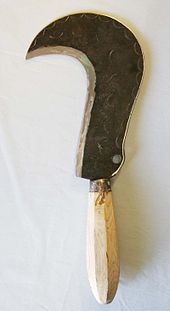
The forerunners of hip-shaped vine knives can be traced back to the Iron Age . There are finds from the Latène period and Roman hook knives that were found near Nattenheim in the Eifel. The curved vine knife was also important in Roman mythology as a prop for the field and forest god Silvanus . Silvanus is shown in numerous pictures half-naked with the vine knife in his right hand and is also adorned with field crops. Vine knives appear regularly during excavations north of the Alps, which is often interpreted by archaeologists to mean that the Romans practiced viticulture at such sites . Like the knife- like hip knives, the Romans brought their typically curved vine knives (falx vinatoria) with them with the spread of viticulture in the 2nd and 3rd centuries in Gaul and Germania .
In contrast to the larger foliage knives, the smaller ones have a blade with a length of 5 to 15 cm and are mainly used for pulling cuts, that is, the user pulls the knife towards himself when cutting. More rarely, the pruning knife is also used to cut by pressing, but never chopped. Otherwise, the shape of the grapevine knife resembles the widespread hauknife-like hip, so the blade is pointed and ends with a more or less concave arch. Wimmer has typed the form and use of the vine knives and garden hips.
The vine knife, like all Hippen, consists of a sickle-shaped curved blade (with the cutting edge on the inside) made of forged steel and a mostly turned handle made of wood, which of course has to lie comfortably in the hand. More valuable vine knives had a handle made of special material, for example horn or yellow boxwood . The handle and the blade were occasionally decorated and the winemakers carried the knife with pride. In some wine regions a real cult was practiced with the winemaker's knives.
Winemakers used the vine knife to prune the vines and to cut out the grapes, as well as during harvest . It was most widespread between around 1650 and 1850. At least in viticulture, it has practically no longer been used since the introduction of the pruning shears (around 1950 depending on the region).
Heraldry and folk art
The pruning knife often appears as a symbol of the vintner's status in stonemasonry in wine-growing areas, especially in the gates of old wineries or in other prominent places on buildings, such as on the stone slides of cellar windows. Two crossed vineyard shapes adorn a coat of arms window in Heilbronn's Kilian Church from 1487. It is also found in the coats of arms of many municipalities, less often in family coats of arms.
Coat of arms of Bickensohl in the Kaiserstuhl
Coat of arms of Großenlüder , district of Fulda
Coat of arms of Haltingen , district of Loerrach
Worms-Heppenheim coat of arms
Coat of arms of Köndringen , Emmendingen district
Coat of arms of Laudenbach , Rhein-Neckar-Kreis
Coat of arms of Lorsbach , Main-Taunus-Kreis
Coat of arms of Malterdingen , Emmendingen district
Coat of arms of the district of Siegen : Heppe (or Knipp) as a symbol for the Hauberg
Coat of arms of Stockheim , Heilbronn district
Coat of arms of Talheim , Heilbronn district
Coat of arms of Waigolshausen , district of Schweinfurt
Coat of arms of Zell-Weierbach , Ortenaukreis
Coat of arms of Mattersburg , Austria ( uncertain )
Family coat of arms of those of Dietrichstein in Carinthia
Municipal coat of arms of Gächlingen , Switzerland
Rebmutz in the coat of arms of Tüscherz-Alfermée , Switzerland
Rebmutz in the coat of arms of Twann , Switzerland
Garden hip
The smallest version of a curved knife is the garden stick or gardener's stick . Corresponding devices are mentioned as early as the 15th century. In contrast to the vine knife, the garden stick is still widely used today.
The gardener's stick is usually designed as a folding knife . The handle length of the garden stick offered today is between approx. 9 cm and 12 cm, the foldable blades are only a few centimeters shorter. The handles are often built with wooden cladding, brass inlays and brass rivets and, depending on the design, have a weight of 50 g to 170 g.

Garden hips are used by many gardeners and tree nurses as universal knives. They are mainly used to refine woody plants .
With goat's foot refinement , the notches are made with the hip, especially for thick underlays, while copulating knives with a straight cutting edge are often used for smaller travelers. The garden stick is also suitable for lifting the bark during so-called paving . In fruit growing, hips are often used to clean out wildlings and to trim sturdy grafts.
In the nursery, larger gardeners ' sticks are often used, for example for cutting off cuttings , cuttings and slender wood shoots. Lighter garden hips are used to care for perennials or like a small sickle when harvesting in the herb garden.
Exhibitions
- Forest Museum Ballenberg in Switzerland ( online )
- Tool museum of the company Les Amis de l'Outil in Bièvre ( online )
- Kleingartach wine-growing bar in Eppingen ; Vine knife ( online )
- Musée de la Vigne et du Vigne de l'Abbaye de Sainte Radegonde in Le Loroux-Bottereau ; Viticulture Museum ( online )
- Musée National des Arts et Traditions Populaires in Marseilles ; Cutting tools from viticulture ( archive version )
- German Wine Museum in Oppenheim ; Vine knife ( online )
- Siegerland Museum in the Upper Castle in Siegen; Haubergsknipp ( online )
The hip in the Bible and poetry
- In his translation of the Bible, Luther translated the Greek δρέπανον / drépanon / sickle with hip , as far as the function of the vine knife was mentioned. Revelation 14.14-19 reads:
“ 14 And I saw / and saw / a white cloud / and on the cloud there was a / who was like a human son / who had a golden crown on his hay and in his hand a sharp sickle 15 and another angel went out the temple / and scream with a great voice to the / who sat on the clouds / strike with your sickles and harvest / for the time to harvest has come / because the earth's harvest has become dry. 16 And he who sat on the clouds struck the earth with his sickle, and the earth was harvested. "
“ 17 And another angel went out of the temple in heaven / he had a sharp hip. 18 And another angel went out of the altar / who had power over the fewr / Vnd rieff with a great shout to the one who had the sharp hip / and spoke / hit with your sharp hip / and snowed up the drifts / because jre Beers are ripe. 19 And the angel struck the earth with his hip / and snows the branches of the earth / and threw them into the great wine press of the wrath of God. 20 And the wine press was pressed outside the city / and the blood went from the wine press to the horses' legs / through a thousand six hundred way through the fields. "
In the first ecclesiastical revision of the Luther Bible in 1892, the name Hippe was retained, as was the version from 1912 (2nd revision), but it was marked with a note and declared "Rebmesser". In the text version from 1984 (3rd revision) the hip was replaced by the term winegrower's knife .
- In one of the popular verses of the Old Testament (Isaiah 2,4), Luther used the term hip for the vine knife,
“ 4 And he will judge the Gentiles / and many peoples will tighten / then they will make your swords into plowshares / and your spits into sickles or hips. For no people will pick up a sword against the other and will never learn to get any more. "
The Luther edition of 1912 still used the term hip, while the 1984 translation only mentions the sickle.
In poetry, the hip (synonymous with scythe or sickle) represents the tool of death . The reaper wields her sickle like the mower leads his scythe, and death in the pictorial representation has his scythe or hip .
- To a skull without pigtails and forelock, His head became a bare skull; His body to the skeleton With hourglass and hip. Gottfried August Bürger - Leonore drove around the dawn
- He swung his hip threateningly. The fearful skeleton said threateningly: Away, you dear Bacchus servant! Gone, you've had enough drinking! Gotthold Ephraim Lessing - The death
- In splendid robes, their heads wreathed, and laughing on their lips, they sit happily at the banquet of life. Then she suddenly hits the hip. Heinrich Heine - Miserere
- you can see the good times now; all you need is the hourglass and the hip, .. Novalis - Heinrich von Ofterdingen.
- Hollow and gaunt, walking skeletons, they pant in the Cocytus boat. Give the poor hourglass and hip, Huh! - and before you stands death. Friedrich Schiller - The Venus Chariot.
- Between the pillars, however, with a view of the hallway, was a rococo clock with a god of time above it, who led a hip. Theodor Fontane - The Stechlin.
- And if you keep him for ten years, he will find me, I'll live that long, I know that, remember, death, from now on I'll be a stone in front of your hip, it will sooner shatter than hold me out of place move. Friedrich Hebbel - Maria Magdalena
- Once a skeleton sits, high on the wagon in front, wears a hip instead of a whip, an hourglass instead of a horn - ... Rudolf Baumbach - The wagon rolls (known as the folksong Hoch auf dem yellowwagen ).
literature
- Anton Birlinger: Swabian-Augsburg dictionary . Munich 1864.
- Gerhard Blum, Peter Lutz: Rüttibrennen - a rare spectacle. The Kinzigtal district is reviving old fire technology. In: The Black Forest. 1/2008 Freiburg (online) (PDF; 8.6 MB)
- Lucius Junius Moderatus Columella, Rutilius Taurus Aemilianus Palladius : The field Lucii Columelle and Palladii: keep in all veldbaw, wine, fruits, all kinds of crops, obscene ... and all kinds of gardening or vaccination. Item the cattle procession, as again horse, sheep ... And arzney against eynes yeden thires ill ... Verteûtschet by Michael Herren. Rihel, Strasbourg 1538.
- Petrus de Crescentiis: Of the use of things that are built in the fields. Peter Drach, Speyer 1493.
- Auguste Demmin: The weapons of war in their historical developments. P. Friesenhahn, Leipzig 1893.
- Wolfgang Gaitzsch : Roman tools. ( Memento from August 6, 2013 in the Internet Archive ) (= Small writings on the knowledge of the Roman occupation history of Southwest Germany. 19, ZDB -ID 236356-2 ). Society for Prehistory and Early History in Württemberg and Hohenzollern a. a., Aalen 1978.
- Theodor Häußler: The vine knife in Old Bavaria. BaierWeinMuseum Contributions to the history of viticulture in Altbayern 16: 20 S. Bach ad Donau 2014
- Friedrich Kluge : Etymological dictionary of the German language . 25th edition. de Gruyter, Berlin 2011, ISBN 978-3-11-022364-4 .
- Manfred Kotterba: Sucellus and Nantosuelta: Investigations into a Gallo-Roman pair of gods in the northern provinces of the Imperium Romanum. Diss. Univ. Freiburg. 1999/2000. (online) (PDF file; 1.50 MB)
- Eduard Hoffmann-Krayer : Review by Giovanni Giordani - La colonia di Alagna-Valsesia e il suo dialetto. Journal of German Antiquity and German Literature 39: 26-39. Hirzel 1895.
- Michael Machatschek: Foliage stories: practical knowledge of an old tree economy, food and fodder foliage culture. Böhlau, Vienna 2002, ISBN 3-205-99295-4 .
- Henri Louis DuHamel du Monceau: About the felling of the forests and proper use of the felled wood or how to deal with the felled wood ...: Along with a description of the craftsmen who do their work in the forests. Translated into German by Carl Christoph Oelhafen von Schöllenbach. 1st part. Winterschmidt, Nuremberg 1766.
- Friedl Scheer-Nahor: The jump to the chainsaw was too big. What does the Säsle have to do with the Saxons? In: Badische Bauern Zeitung. January 21, 2006.
- Karl-Rolf Schultz-Klinken: The development of rural hand tools in south-west Germany. In: The Museum Friend. 14/15 1975, pp. 9-109.
- Clemens Alexander Wimmer : Die Häpe (serpe, billhook). History and shapes of a little known garden tool. In: Zandera. 23 (1) 2008, ISSN 0940-9920 , pp. 1-29.
- Clemens Alexander Wimmer: On the history of the hip. In: Swiss Society for Garden Culture SGGK (Hrsg.) : Culture techniques: garden art and gardening handicraft. vdf Hochschulverlag, Zurich, 2010, ISBN 978-3-7281-3276-5 , pp. 56–68.
Individual evidence
- ↑ Kluge / Mitzka, Etymological Dictionary, p. 310
- ↑ Wolfgang Pfeifer: Etymological Dictionary of German . 7th edition. Deutscher Taschenbuch Verlag, Munich 2004, ISBN 3-423-32511-9 , pp. 545 .
- ↑ Kluge / Mitzka, Etymological Dictionary, p. 705
- ^ A b Friedrich Ludwig Karl Weigand: Dictionary of German synonyms. 2. Vol., Florian Kupferberg, Mainz 1842, p. 87, full text in the Google book search
- ↑ Scheer-Nahor, The jump to the chainsaw was too big. What does the Säsle have to do with the Saxons? Archive link ( Memento from August 15, 2010 in the Internet Archive )
- ↑ Birlinger, Swabian-Augsburg Dictionary, p. 400
- ^ Oskar Schade : Old High German Dictionary. Vlg. Der Buchhandlung des Waisenhauses, Halle 1866, p. 186, full text in the Google book search
- ^ Hoffmann-Krayer, Review by Giovanni Giordani , p. 34
- ↑ Machatschek, Laubgeschichten, p. 117
- ^ Luxembourg dictionary
- ^ S. Muhl: The viticulture on the Moselle and Saar, as far as they belong to the crown of Prussia ... Verlag C. Troschel, Trier 1845
- ^ Palatine dictionary
- ↑ Sutter, Jürgen: Opfinger dictionary. 509 S. Schillinger Verlag Freiburg 2008.
- ^ Höfflin, Horst Christian: On the language of viticulture at the Kaiserstuhl and Tuniberg. 324 S. Kümmerle, Göttingen. 1983
- ↑ Wimmer, Zur Geschichte der Hippe, p. 67
- ↑ Wimmer, Die Häpe, p. 10
- ↑ International and interregional specialist dictionary on the language and culture of wine, entry: Rebmutz
- ↑ Schultz-Klinken, The Development of Rural Handicrafts in Southwest Germany, pp. 71f
- ↑ Demmin, The War Weapons in Their Historical Developments, p. 711
- ↑ The description can be found in the chapter Von öpffeln von affrica, whose cultivation is also reported in the German edition, although the pomegranate was never grown north of the Alps.
- ↑ Hippen for the production of whipping in the 18th century
- ↑ Cobbler Bars
- ↑ Wimmer, Die Häpe, p. 26
- ↑ site about Bill Hooks
- ↑ Website with photos of decorated Haubergsknipps
- ↑ Machatschek, Laubgeschichten, p. 117
- ↑ Forstmuseum Ballenberg: Description of the form and use of the device (PDF file; 1.25 MB)
- ^ Description by Heinrich Jung-Stilling on the Haubergsknipp
- ↑ Haubergsknipp awarded. The West. May 14, 2007
- ↑ Blum & Lutz, Rüttibrennen - a rare play, pp. 11–13
- ↑ A “Säsli” for the clapboard maker. - Badische Zeitung September 9, 2009
- ↑ Fasnachtsfüür / Schiiblischiesse in Ettingen ( Memento from April 8, 2014 in the Internet Archive ) (PDF file; 6.71 MB) - Birsigtalbote February 22, 2007
- ↑ [1]
- ^ Catalog Maxime Leloup around 1920
- ^ The holdings of the Sigmaringen State Archive: Südwürttemberg 1806–1996. P. 179. Kohlhammer Stuttgart 2000
- ↑ TINA knife factory Reutlingen
- ↑ Wimmer, Zur Geschichte der Hippe, p. 56
- ↑ Kotterba, Sucellus and Nantosuelta
- ↑ Wolfgang Gaitzsch : Roman tools. ( Memento from August 6, 2013 in the Internet Archive ) (= Small writings on the knowledge of the Roman occupation history of Southwest Germany. 19, ZDB -ID 236356-2 ). Society for Prehistory and Early History in Württemberg and Hohenzollern a. a., Aalen 1978.
- ↑ Wimmer, Zur Geschichte der Hippe, p. 2 f.
- ↑ Helmut Husenbeth: The chair - an ancient vintner's device that gave the Hainfeldern its name ( Memento from July 19, 2011 in the Internet Archive )
- ↑ Wimmer, Zur Geschichte der Hippe, p. 56
- ↑ Representations of vine knives on stone crosses, coat of arms windows or arches
Web links
- Drawing of a hip ( Memento from September 28, 2007 in the Internet Archive )
- Historical replica by Ars Replika eV , Association for Living Archeology
- Old Bill Hooks - Private site to hip (English)
- private page Das Säsle

